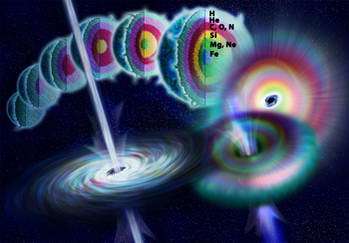Swift detects most distant explosion in the Universe

Scientists using the NASA Swift satellite and several ground-based telescopes have detected the most distant explosion yet, a gamma-ray burst from the edge of the visible Universe.
Image above: Stars shine by burning hydrogen. The process is called nuclear fusion. Hydrogen burning produces helium "ash." As the star runs out of hydrogen (and nears the end of its life), it begins burning helium. The ashes of helium burning, such as carbon and oxygen, also get burned. The end result of this fusion is iron. Iron cannot be used for nuclear fuel. Without fuel, the star no longer has the energy to support its weight. The core collapses. If the star is massive enough, the core will collapse into a black hole. The black hole quickly forms jets; and shock waves reverberating through the star ultimately blow apart the outer shells. Gamma-ray bursts are the beacons of star death and black hole birth. Credit: Nicolle Rager Fuller/NSF
This powerful burst, marking the death of a massive star and the birth of a black hole, was detected on 4th September. It comes from an era soon after stars and galaxies first formed, about 500 million to 1 billion years after the Big Bang. The science team cannot yet determine the nature of the exploded star; a detailed analysis is forthcoming.
This is uncharted territory, said Dr Daniel Reichart of the University of North Carolina (UNC) at Chapel Hill, who spear headed the distance measurement. This burst smashes the old distance record by 500 million light years. We are finally starting to see the remnants of some of the oldest objects in the Universe.
Professor Keith Mason, UK lead scientist on the Ultra Violet/Optical Telescope on Swift and Chief Executive of the Particle Physics and Astronomy Research Council said, "This is an amazing result that will enable us to find out more about stars from near the beginning of time. Swift is operating brilliantly first detecting the gamma rays bursts and then alerting telescopes across the world to enable follow up observations a truly international mission combining space and ground based astronomy.
Only one quasar has been discovered at a greater distance. Yet whereas quasars are supermassive black holes containing the mass of billions of stars, this burst comes from a single star. Scientists say that it is in fact puzzling how a single star could generate so much energy as to be seen across the entire Universe. This early star is perhaps physically different from the kinds that exist today.
Scientists measure cosmic distances via redshift, the extent to which light is shifted towards the red (lower energy) part of the electromagnetic spectrum during its long journey across the Universe. The greater the distance the higher the redshift.
The September 4th burst, named GRB 050904, had a redshift of 6.29, which translates to a distance of about 13 billion light years from Earth (the Universe is thought to be 13.7 billion years old). The previous most distant gamma-ray burst had a redshift of 4.5. The most distance quasar known is at redshift 6.4. GRB 050904 was also very long, lasting over 200 seconds. Most bursts last only about 10 seconds.
Swift detected the burst and relayed its coordinates to scientists around the world within minutes. Reicharts team at UNC discovered the afterglow with the Southern Observatory for Astrophysical Research (SOAR) telescope atop Cerro Tololo, Chile. Over the next several nights, the UNC team used SOAR and the Gemini South telescope, on Cerro Pachon, to calculate a redshift of 6 via a light filtering technique.
Dr Nial Tanvir from the University of Hertfordshire, observed the afterglow of the burst on the United Kingdom Infrared Telescope and Gemini South comments, How a single star could generate so much energy as to be seen across the whole of the Universe remains an unanswered question. The fact that we can see it now may provide us with a new tool to help understand those very early times.
Gemini South Associate Director, Phil Puxley, comments on the key observations at Gemini South, "Timing is everything when it comes to making an observation like this - this is short-order astronomy! Getting good data is always rewarding but when we can catch something as fleeting as a Gamma Ray Burst the thrill of the chase is added to the mix."
Building upon these measurements, a team led by Nobuyuki Kawai of the Tokyo Institute of Technology used the Subaru Observatory on Mauna Kea, Hawaii, to confirm the distance and fine-tune the redshift measurement to 6.29 via a technique called spectroscopy.
A team of Italian astronomers, using one of four 8.2 metre telescopes that comprise the European Southern Observatorys Very Large Telescope (VLT) observed the object in the near-infrared and in the visible. By comparing the brightness of the source in the various bands, the astronomers could deduce its redshift and, hence, its distance. The value they derived was confirmed by the spectroscopic observations made by the team using the Subaru telescope.
We designed Swift to look for faint bursts coming from the edge of the Universe, said Dr Neil Gehrels of NASA Goddard Space Flight Center, Greenbelt, MD., Swift Principal Investigator. Now weve got one and its fascinating. For the first time we can learn about individual stars from near the beginning of time. There are sure to be many more out there.
The detection of GRB 050904 confirms that massive stars mingled with the oldest quasars and that even more distant star explosions perhaps from the first stars, theorists say can be studied through a combination of Swift and the network of world-class telescopes.
Source: PPARC


















